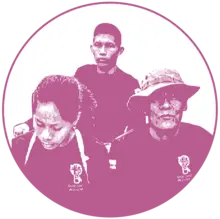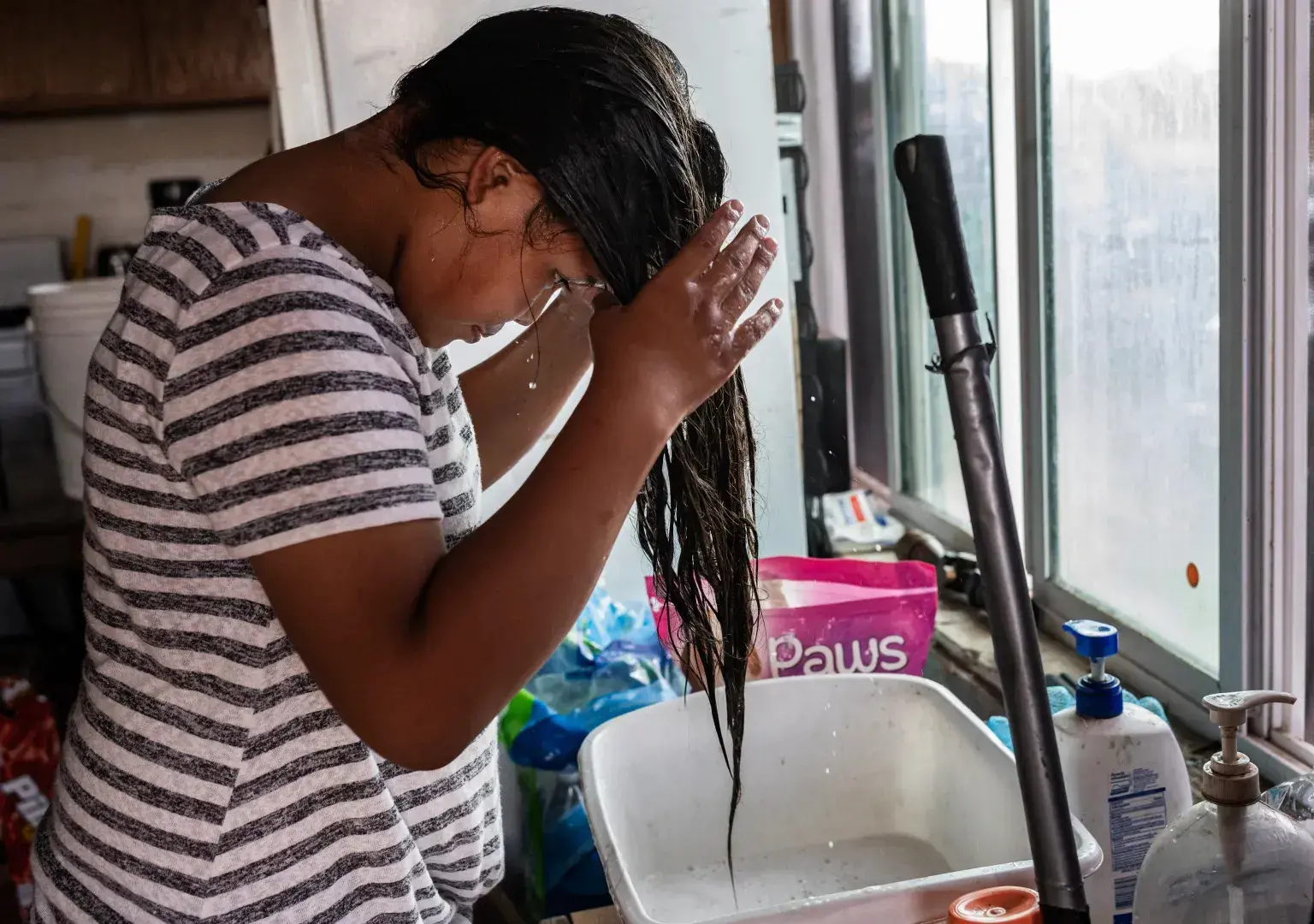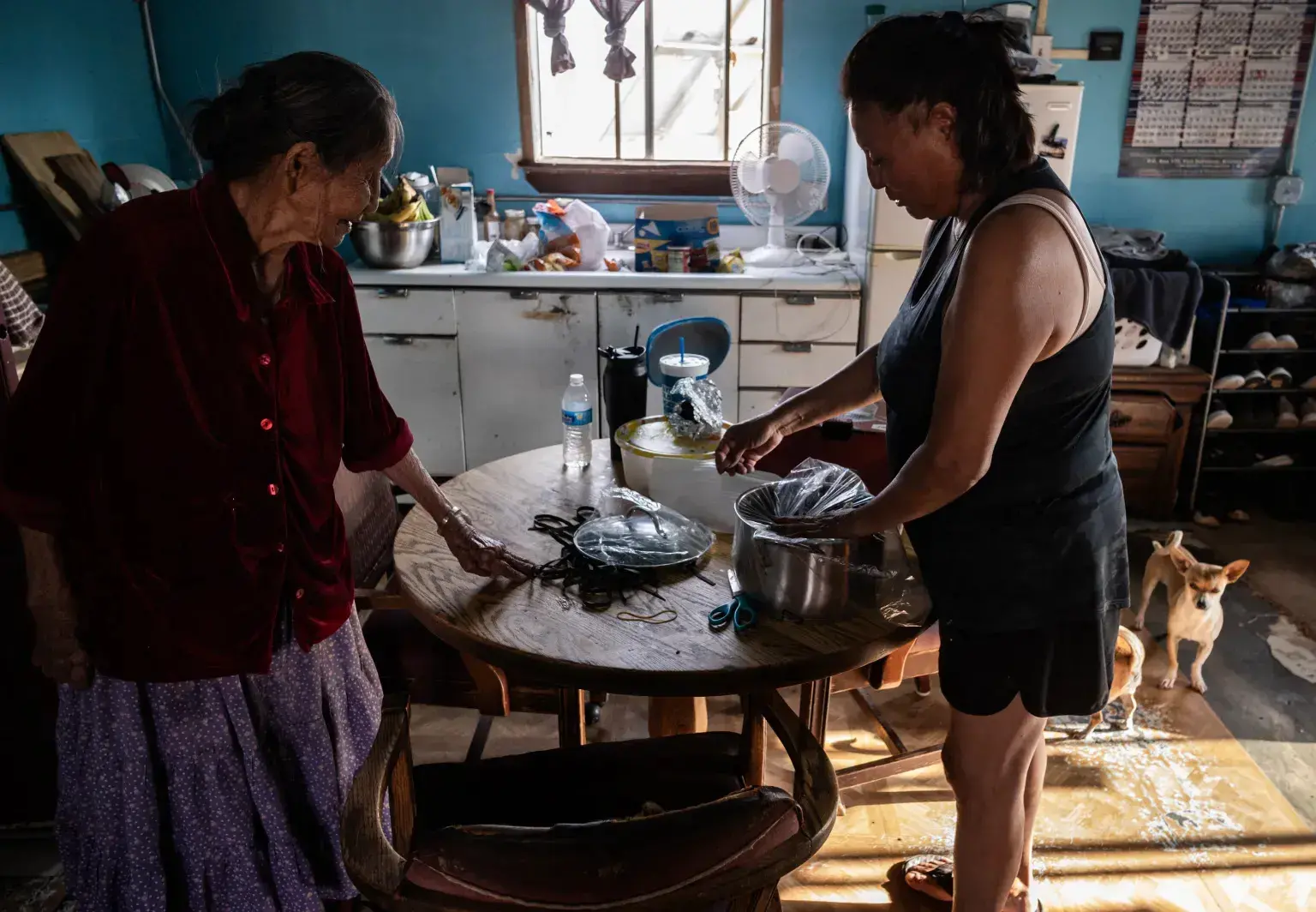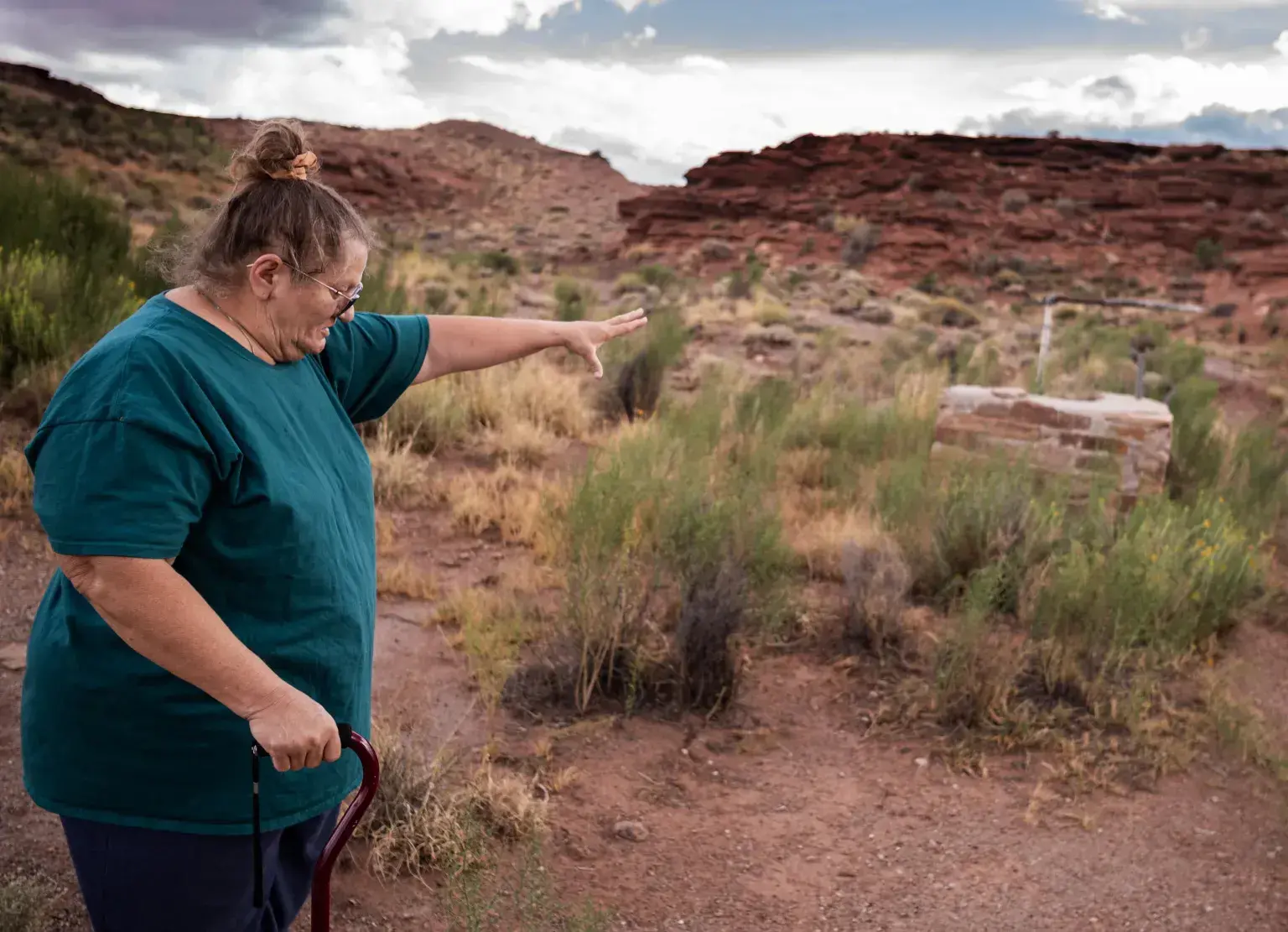
Thousands of Navajos have no clean running water at home, a crisis magnified by drought and government neglect. This is how families cope.
OLJATO, Utah — A bespectacled 65-year-old woman with raven hair bundled in a claw clip opens the wire gate to an unlikely plot of corn in a remote sandstone canyon near Monument Valley Navajo Tribal Park.
She brings a baking pan from her truck and begins to collect pollen from chest-high corn planted in eight neat rows. Rita Haycock, a member of the Oljato Chapter, is saving the pollen for use in Navajo (Diné) ceremonies, including wedding rites. A small pouch of it will fetch her $20.

Haycock, her three grandchildren in tow, backs up her Ram pickup truck to the fence line. She has just filled a 275-gallon water tank in the truck bed at the spring at Goulding, a six-mile drive from her garden on sandy, unpaved roads. She shows her grandchildren how to rake a channel in the parched earth. A hose from the water tank will quench the thirsty plants.

As a nonprofit journalism organization, we depend on your support to fund coverage of Indigenous issues and communities. Donate any amount today to become a Pulitzer Center Champion and receive exclusive benefits!
Haycock and her husband, Henry, repeat this routine sometimes twice a day during their free time while working as tour guides in the tribal park. Growing corn in this arid landscape is a herculean task.

Across the Navajo Nation, 170,000 or so residents are struggling with the worst ongoing drought in a century. Many are accustomed to using just a fraction of the water other Americans consume — as little as two to seven gallons a day compared to 80 to 100 gallons for the average U.S. citizen. They travel long distances to haul water for personal use and to feed livestock.
“Navajos have always rationed water use and intake due to scarcity,” said Reese Cuddy, a research associate at the Johns Hopkins Center for Indigenous Health in Fort Defiance, Arizona.
Climate change has made life harder on the reservation, with little access to clean drinking water for the once predominantly pastoral people.
The U.S. government has not helped. On June 22, the U.S. Supreme Court ruled 5-4 that the federal government was not obligated to help the Navajo meet their water needs. Justice Neil Gorsuch wrote an impassioned dissent.

In 1922, water rights were established in the Colorado River Compact, dividing the river into two basins and allowing seven states to divvy up the valuable resource. The Navajo Nation — whose 27,000-square-mile reservation spans Utah, Arizona and New Mexico — was left out of the negotiations. The tribe’s rightful share of the water was left unresolved.
“You see all these cities that have water fountains, that have lawns, and so forth. This is what they are using the Colorado water for,” said Don Begay, a driver for DigDeep, a nonprofit with a branch in Thoreau, New Mexico, that has installed more than 600 water-pump systems while delivering free water to families in remote Navajo lands.

In the past, the Diné would take their animals to places where grass and water were found. Now they go through extraordinary efforts and pay enormous costs to bring water to where they live.
“Navajo families that need to haul water spend an average of $43,000 per acre-foot of water, while the average American water user spends only $600 per acre-foot of water,” according to a study cited in DigDeep’s amicus brief in the Supreme Court case.
A long drive for water
Still dressed in their Sunday church clothes, Cassie Scott and her husband, Donovan, stop at a water-filling station in Page, Arizona, before heading back to their double wide on a patch of desert-facing land outside the LeChee Chapter tribal housing, a few miles south of Page. Cassie Scott is the chapter’s vice president, but like many on the reservation, her home does not have piped clean water or a bathroom. (The family uses a portable toilet.)

It would cost $10,000 for the family to hook up to the water pipeline that serves most residents of the chapter. Instead, they rely on their truck to fill their 750-gallon water tank.
The chapter’s water comes from Lake Powell, a man-made reservoir on the Colorado River, through an indirect arrangement with Page, a town developed after the damming of the Colorado.
Helena Begay, a Navajo Nation Council Delegate who represents five chapters, regularly hauls her family’s water from Page to her home 21 miles away. She feeds quarter after quarter into a water station meter to meet her water needs.
“Yes, let the Navajos have their water rights,” she said while sitting at her dining room table. “We suffer out here. We are the people who have to haul water.” She dreams of a day when water from Lake Powell could be piped to her home.
Sweeping vistas, harsh realities
On an afternoon of gray skies and pregnant clouds at Horseshoe Bend, tourists joust to snap selfies on the 1,000-foot ledge overlooking a meandering 270-degree curve in the Colorado River.

The distance and awe created by the vantage point might as well describe the relationship between the Navajo people and the Colorado. The river water has fueled the growth of cities like Las Vegas while leaving the Diné struggling to find water sources in the desert.
“The ultimate hope would have been to right the wrongs and to increase water access and infrastructures,” said Ashley Thacker, senior research program supervisor at the Center for Indigenous Health.
Thacker is surveying households served by the Fort Defiance Agency, a federal office that oversees 27 Navajo Nation chapters, to determine exactly how many homes have running water. Estimates run from 6 to 40 percent, largely depending on how close a home is to a water pipeline. She and her colleague, Reese Cuddy, hope the survey, which will include assessing water quality, can shape tribal and federal policy to help the Navajo people.

A rare shower may be possible
East of Thoreau, New Mexico, it’s August 16, and school has begun for 11-year-old Aubrey Martinez, a shy girl with lustrous dark brown hair. She stands over a kitchen sink with a half-filled plastic tub, meticulously rinsing the strands of hair.
“It’s hard, but we get by, ” said her mother, Devona Juan. “It’s a struggle every day.” The kitchen sink serves as the only bathroom. The outhouse is in the yard.
Juan has found work shuttling seniors and those with health issues to doctors’ appointments. Her husband, Darrin Martinez, has been out of work for months. A single faucet carries water to the house from an underground tank that needs to be filled with hauled water.
There is no piped water because a gas pipeline is currently blocking the construction of a water pipeline that would serve this group of homes on a hillside south of Interstate 40, a few miles outside of Thoreau. The family’s single-room house, cobbled together with plywood and a roof that sometimes leaks, is temporary, until the local tribal housing authority can replace it with new construction, Juan said.
Her children have never used a bathtub, she said. “So maybe Sunday, when it’s time to go back to school, I would say it’s the only time” the kids are able to shower properly, either at their grandparents’ home up the hill or by using buckets outside.
Pride and resilience
Near the landmark of Hosta Butte, New Mexico, on a remote ranch in the foothills north of Thoreau, DigDeep driver Don Begay fills the underground water tank of 83-year-old Virginia Snyder with fresh, clean water from Gallup. The waist-high port gurgles and hums until the water nears the top with a closing whoosh. Then it’s time to shut off the valve.

Behind the home are piñon trees, which produce nuts that were once a staple food of the Navajo. But they have not produced in years because of drought, Snyder said.
Standing in her kitchen, Snyder talks of her troubles in a pleading Diné banter with Begay, who enjoys talking to elders on the reservation as he makes his rounds. Her hot water heater is not working properly, and she is looking for help. She has also requested, to no avail, that the Navajo housing authority help her winterize her home so the pipes don’t freeze in the coming months. Cold temperatures can come early at this 7,000-foot elevation.
In the winter, Begay’s water truck can’t make it to this remote area. The roads are too poorly graded. The family will have to fend for itself or rely on friends and neighbors. “In the middle of the U.S., we actually have what would be considered a Third World country,” Begay said.
Old uranium mines, lingering problems

Near a trading post in Cameron, Arizona, Evelyn Curley, 78, pin curlers still in her hair, gets into her truck to drive up a hillside to a sheep pen where she keeps several dozen lambs. Across the road is the small bungalow with no water or electricity where her daughter and children live, just off U.S. Highway 89.
Every other day, Curley lets her sheep out to graze on hillsides nearby. But she steers them away from Uranium Mine A&B No.3, an abandoned site where her children played growing up. During the 1940s and 1950s, hundreds of mines operated on the Navajo Nation, where workers and communities were exposed to the radioactive ore without any warning of the dangers. The mines eventually shut down, but most of them were never properly cleaned up or sealed off.

Guy Horsen, a former contractor who helped backfill some of the mines in the Cameron area, offers a tour. When he takes a reading on his Geiger counter at Uranium Mine A&B No.3, he says the radiation levels are four times higher than the background level. More than 500 such abandoned mines dot the reservation.
Curley, whose sister and brother both died of cancer, worries about the exposure, especially when rain brings contaminated soil down the hill. She and her daughter both have thyroid issues. Her children “played up here at the mine on top of the hills,” she said. They would make mud masks and drink water from the drill holes when it rained.
Traditions to carry on

“We have drought every year. Our rain comes later. We have to go through a lot of heat and a lot of water for our livestock,” said Linda Begay, 57, who moves about her sheep and cattle ranch with a small army of chihuahuas on an isolated plateau near Grand Falls, Arizona. Her husband, Ralph, has a good job in Flagstaff, 45 miles away, and can bring home drinking water in small containers. The water for her sheep and cattle is hauled from Leupp, an hour’s drive on unpaved roads.
It hasn’t always been this way. Begay and her siblings grew up getting drinking water for the family and the livestock from the Box Spring well, about six miles from their home. That well was closed because of contamination, she said, but a few residents still draw from it.

Begay, who suffers from a chronic crippling urinary tract infection that causes sweats, backaches and pain, has paid a price for the lack of clean water access. So has her mother, Alice Tso, 91, who had a portion of her colon removed because of cancer and suffers from arthritis and other ailments.
Tso filed for compensation from the federal government for uranium poisoning victims but was denied twice. Begay hasn’t filed a claim, saying, “I just figured it was a waste of time. I didn’t bother with it.”
Begay’s daily routine includes feeding hay to her horses and sheep that costs $28 for a three-wire bale. And it’s $80 for a load of water, which lasts about a week. The costs add up, along with the price of gas, and wear and tear on their trucks.
“We have to go so far out to get water,” she said. “Our government, they are not concerned. They don’t help us. They are not around here.”
Yet she remains stoic, looking out for her animals and her parents, who live next door.
“We stay out here because, you know, that is where we grew up,” Begay said. “And we are told to take care of the land, to carry on the tradition, to carry on the livestock that our mom and dad left behind.”
‘You got to have hope’

On an early morning just after sunrise in Two Grey Hills, an hour north of Gallup, Irene Bennalley feeds her cackling geese on a small farm surrounded by desert scrub. Her sheep are up on the mountain grazing. Her son is looking after them. The goats and horses will need to be fed next.
“I got to take care of them while they take care of me in return,” said the 66-year-old, who has a proud libertarian streak. Bennalley spins wool and weaves traditional Navajo design rugs that can fetch $2,500 apiece. She learned how to weave from her mother and how to herd from her father.
She, too, must haul water from nearby springs. “There might be water in the ponds and the lakes, but the ground is still dry,” she said.
Bennalley recalls seeing the landscape turn to sand after she finished high school. Her family used to grow potatoes in the mountains. “I wouldn’t call it climate change,” she said. “I don’t believe in that.” Instead, she calls it a series of weather changes.
These women — Begay, Tso, Curley, Haycock, Bennalley and so many others — persevere, no matter what the climate throws at them and despite a federal government that is unresponsive to their hardships.
“Hope is always there right with me,” Bennalley said. “No matter what, you got to have hope. If it rains or not, we got to live. We got to still survive.”














